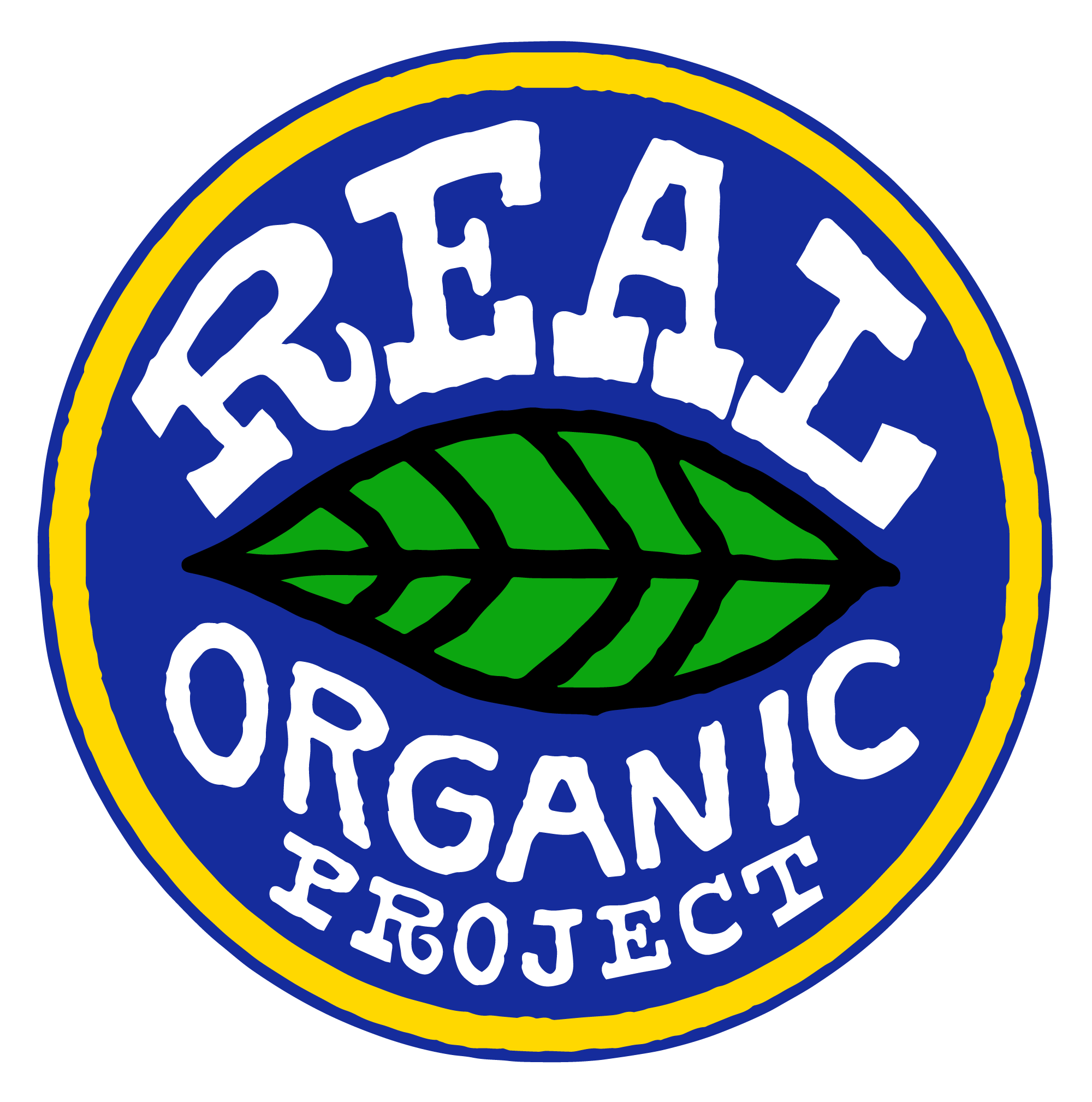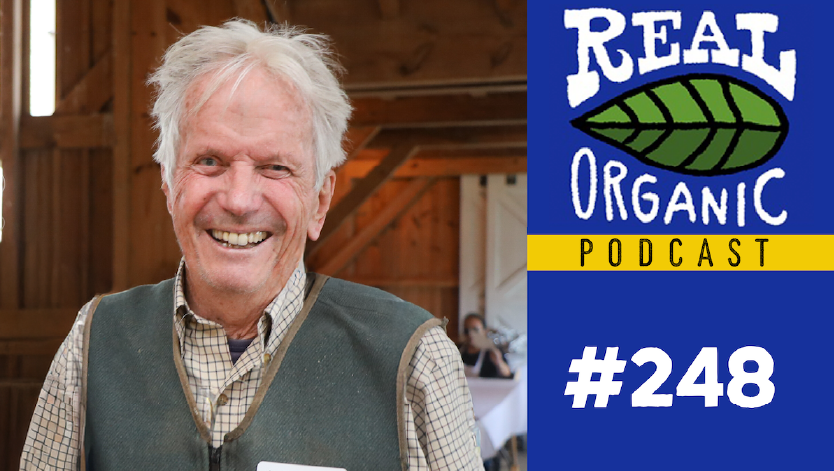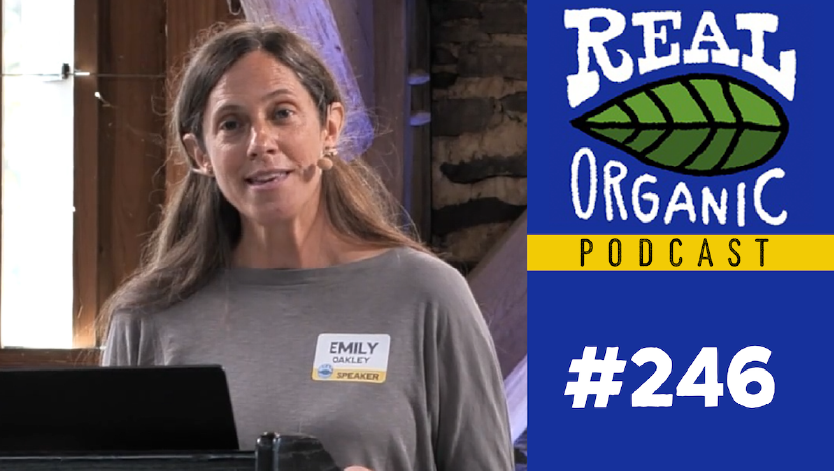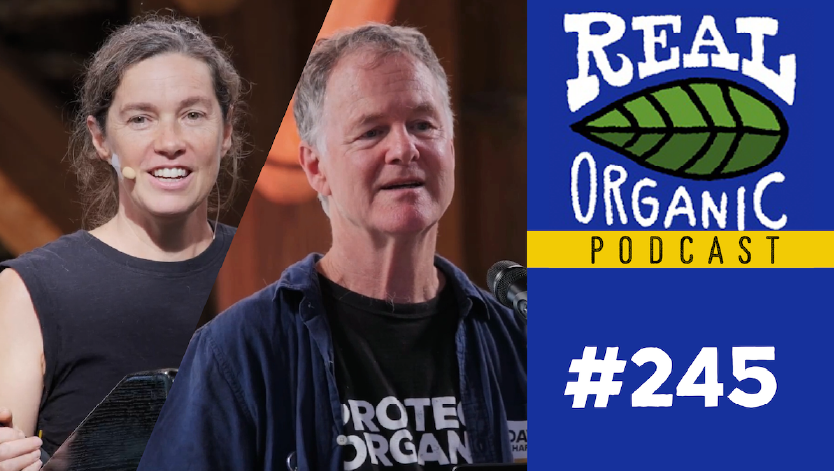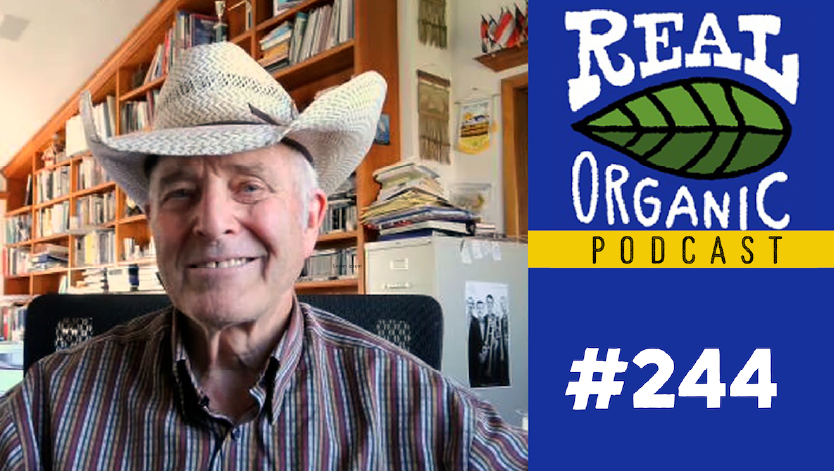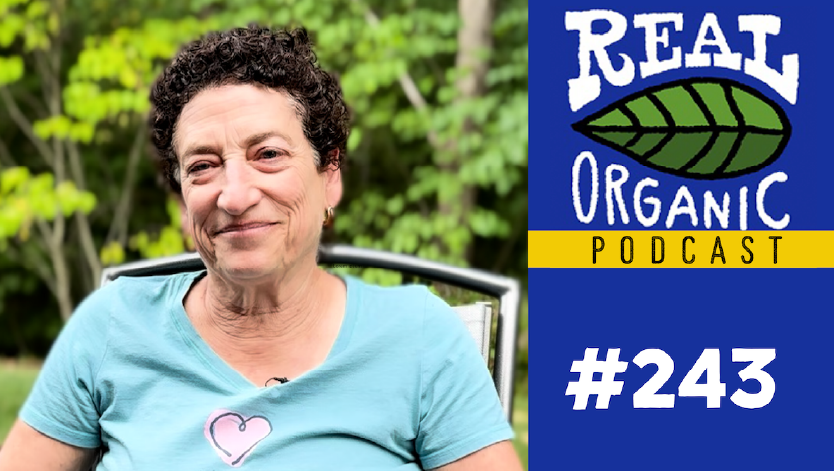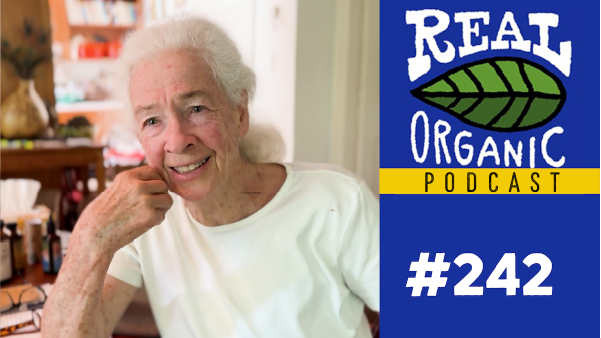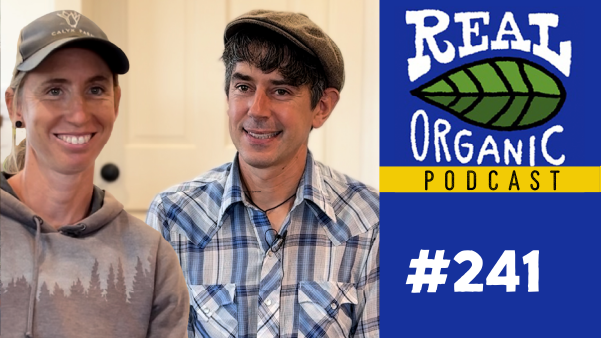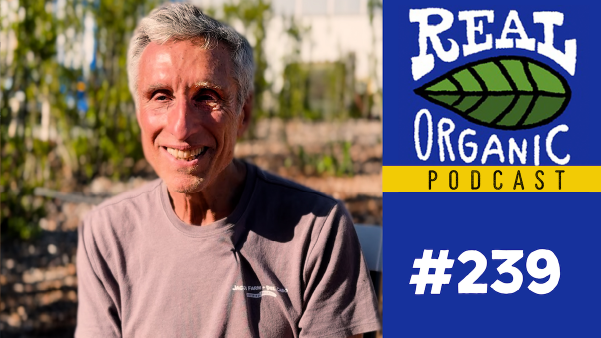Episode #220
Sharon Lerner: PFAs In Food
Investigative journalist Sharon Lerner reveals how PFAS—known as “forever chemicals” made their way into our bodies, our food, and our soil. From exposing corporate cover-ups at 3M to unpacking the failure of U.S. chemical regulation, Sharon shares the shocking truth behind these toxic compounds and their ongoing impact on public health and agriculture. “They’re in the water, the food, the soil—and they’re in us.” This episode pulls back the curtain on environmental injustice and asks: what happens when no one is held accountable?
Our Sharon Lerner interview has been edited and condensed for clarity:
You can subscribe and download episodes of our show through your favorite podcast app, our YouTube channel, or stream the audio-only version here:
Dave Chapman interviews journalist Sharon Lerner, March 2025
Dave Chapman 0:00
Welcome to the Real Organic Podcast. I’m talking today with Sharon Lerner who is an investigative reporter at ProPublica since 2022 and, before that, at The Intercept. Sharon, you’ve done amazing work. Your work has shown up in many venues. I probably first found out about you reading the long article on PFAS in The New Yorker, which was excellent.
Sharon Lerner 0:30
Thank you.
Dave Chapman 0:30
You’re welcome. Can I ask how you came to be an environmental journalist?
Sharon Lerner 0:38
Well, I’ve been a journalist for a long time – more than 25 years. I guess for the past 10 to 15 years, I’ve been writing about environmental issues. I think my first environmental story was a very complicated one about a cancer cluster in Florida and how it was connected to a defense contractor nearby and pollution from that contractor. It was a thorny story that took me about a year to write. It was a story that nobody else wanted to report on because it was just too complicated. There was something that clicked for me doing it. I thought, “This is extremely difficult, complicated, and really important. I kind of love it, and I want to do more of it.” That kind of put me on that path.
Dave Chapman 1:40
I think it was Ken Cook who said you seem to get people to talk about things that they don’t easily talk about with other people. Your writing has a lot of human drama to it – talking about these big things that are going on. I know you did a lot during COVID. You were looking at the roots of COVID and the government response to it. I first learned about you through the PFAS story. How many years were you writing on PFAS before you came to Kris Hansen?
Sharon Lerner 2:23
My first story on PFAS was in 2015. It was a three-part series that looked at DuPont’s role in using PFOA – which is a PFAS chemical – in West Virginia and the contamination near there. It included the story of Rob Billot, the attorney who was later featured in the film “Dark Waters.” Not featured, but the film is kind of based on his story. That was the beginning of it.
Sharon Lerner 3:03
I did that at The Intercept. I was at The Intercept, as you mentioned, until 2022, which was seven years. During that time, I think I wrote about 60 stories about PFAS chemicals. Some of them are extremely long and complicated, and some of them are quick. But I was following those chemicals. I was doing other things as well at The Intercept. I did stay on that story, and it took…
Sharon Lerner 3:32
When at The Intercept, I reported about firefighting foam. We were the first place to report that PFAS were in firefighting foam and that they were a big source of contamination, which is still a very huge issue. There’s a lot of PFAS contamination on military bases where firefighting foam was used, and that basically the foam contained PFAS that seeped into the soil and into the water systems and into drinking water, ultimately.
Dave Chapman 4:13
I think the acronyms are very confusing to a lot of people. PFAS is a term for a whole family of chemicals?
Sharon Lerner 4:22
Yes. There are thousands of PFAS chemicals. Most people call them PFAS. Very confusingly, two of the main best-known chemicals in that class are PFOS – which is sometimes called PFAS – and then PFOA. But honestly, there are thousands of them. They don’t all have names at this point, but what they have in common is that they’re fluorinated compounds, which means that they’re basically chains of carbons, and the carbons are attached to fluorine atoms. Because the carbon-fluorine bond is extremely strong, they’re really persistent. It’s very hard to destroy these things. That’s why they’re sometimes called ‘forever chemicals’ because they last and last, and they persist in the environment. They can be destroyed by being burnt at very, very, very high temperatures. But those conditions wouldn’t occur naturally. So, in nature, they basically persist forever and are expected to be on the planet long after we are gone from it. So that’s why they’re called ‘forever chemicals.’
Dave Chapman 5:50
Just to be clear, they never existed before. They were created in a laboratory.
Sharon Lerner 5:56
Exactly. These are manmade compounds, and it was really hard to make them. It took a lot of chemical know how – chemists figuring out how to get fluorine bonded to carbon. Fluorine is a very reactive molecule, and it’s really dangerous to work with. So, it took a lot of doing to get these compounds made in the first place.
Dave Chapman 6:25
We are very clever. Are PFAS as a class of chemicals dangerous?
Sharon Lerner 6:36
Yes. These compounds are, as I mentioned, very persistent, and they’re very useful in industries. They’re resistant to temperatures because they don’t burn until they reach really, really high temperatures. They’re resistant to water and grease, which means they’re really great for food packaging and for lining things like pans, paper coatings, and fabric coatings. They’re really useful, but it turns out that they’re also toxic.
Sharon Lerner 7:15
Because there’s so many in the class, we don’t actually know how each one behaves in the human body. But we know about a few of them – or more than a few – but a minority of them have been studied. But when they’re studied, we actually see (1) that they accumulate in the human body. You don’t just eat them or come in contact with them and immediately excrete them – they build up. So that’s called bioaccumulative. That’s one of the things that they do.
Sharon Lerner 7:42
The other thing is that they cause harm to various bodily systems. Again, it depends on which individual compound you’re talking about, but sometimes there are a lot of different outcomes. They impact the immune system, some of them cause cancer – various cancers – and reproductive outcomes. They seem to affect lots of bodily systems. So, very dangerous. Because they’re so widespread, pretty much everyone has some level of these compounds in their bodies all the time.
Dave Chapman 8:24
I’m sure, depending on your lifestyle and what you do for a living and all of that, and where you live, there are differences in the blood level. But it was amazing to me – the Kris Hansen story. That’s kind of how Kris got drawn into that story at 3M. Maybe, why don’t we talk about Kris? That she was testing blood, right?
Sharon Lerner 8:47
Kris Hansen was a chemist at 3M. She was working there in the late 1990s. She actually stayed at 3M for a long time, but not in the environmental lab, which is where she was working in the 1990s. She’s the person I wrote about in the New Yorker story you mentioned. How did she get drawn into this work? She was pretty new at the company at the time; she was young, in her 20s. She was the chemist who had expertise in studying trace levels of chemicals. She was asked if she could take a look at human blood that had been tested by an outside lab that 3M had hired.
Sharon Lerner 9:39
They said that there was some contamination in the blood, and could she figure out what it was? She knew, because they told her, that they had long been monitoring their own workers at 3M because they were working with fluorochemicals, what they called PFAS at the time, and they knew that the compounds got into the workers’ bodies. They presented this to her as not a health issue – nothing to worry about – but like, “This chemical is in the workers blood. We gave it to this outside lab to see if they could figure out what’s going on with our monitoring results. The lab is saying that when they compare the workers’ blood to blood from the general public, they’re actually finding the fluorinated compounds, not just in the workers’ blood, but also in the blood of the general public. There seems to be something wrong can you figure it out.”
Sharon Lerner 10:46
She gets to work and starts analyzing these samples of blood that come from blood banks. So, these are from people who should not, presumably, have this chemical in their blood. But every time she tests the blood, she finds trace levels of the chemical in human blood that isn’t from workers. She does it a few times to the point where she’s satisfied it’s not a fluke. She tells her boss, and that sets off a very complicated years-long journey for her of essentially figuring out that this compound was, in fact, in the blood of pretty much everyone. She didn’t realize at the time that it was toxic, but she knew, on some level, that it was a problem. Then the challenge became how to get this information to the right people and get the company to do something about it.
Dave Chapman 11:57
Did 3M know that this chemical was actually dangerous? At what point did they learn that?
Sharon Lerner 12:05
Did 3M know? Yes. It turns out – this is a big kind of turning point in the story – that after a very long time of working on this and becoming convinced herself that this chemical was, in fact, in everybody, and raising the issue to her boss and her superiors, and saying, “Our chemical is in everybody,” and getting a lot of pushback for saying this, after a considerable amount of time had passed, when she’s in this position of trying to alert people and having them say, “You’re being an alarmist and you’re probably wrong. Check your numbers.” She finds out that another chemist at 3M had discovered the same thing decades earlier.
Dave Chapman 13:10
How does it happen that everybody has PFAS in their blood?
Sharon Lerner 13:15
Well, it turns out that it was used in many products. In the beginning, 3M used it in a product called Scotchgard, which is sprayed on furniture, but it was also used on clothing to make it waterproof and stain-proof, and on carpets. Then a similar compound on food packaging. It turns out that there are a lot of sources of exposure. When you have a sprayed carpet or a treated fabric or paper, not all of the chemical remains on the paper or the fabric. Some of it just basically comes off, goes into the air, into the dust, into your mouth, onto your skin, and into your body.
Sharon Lerner 14:09
As I mentioned, it bioaccumulates. Once it’s there, it stays there, and for a certain amount of time. It depends on the compound – how long it stays in your body. But if you’re continually exposed, because it’s one of these things that isn’t so many products. Then even though your body is going to get rid of some of it, if more is coming in, you basically have a constant level.
Dave Chapman 14:33
What about if I were a Chinese peasant? Would I have no PFAS in my blood? Because it’s not maybe in cars and smartphones?
Sharon Lerner 14:47
Interesting question, because ultimately, Kris is going on this journey of learning more and more about this, becoming more alarmed, telling her superiors, and getting pushback, even after she realizes that someone else has figured this out before her – actually I’m not sure of the chronology of that – but one of the things that happens is she decides to look at historical blood samples and see if they have PFAS in them.
Sharon Lerner 15:16
She looks back and finds PFAS in many older blood samples until finally, she finds one that doesn’t contain it. That was actually from, I believe it was rural China – the first one that she found that didn’t contain it. For her, that was some proof that she had been right all along. Because people were saying, “Well, you see PFAS everywhere. You must be making it up. Or maybe your equipment is contaminated. Maybe your method is wrong.” What she ultimately was able to do is show, “Well, no, because this sample, which was taken before we were selling our products, did not contain it. And that’s why I know I’m right.”
Dave Chapman 16:03
I’m still wrapping my head around it. Of course, it’s terrible for her to be in a situation in which everybody that she works with – which is a large corporation, a world that it creates – all telling her that she’s wrong. Maybe that she’s crazy. Maybe she’s really bad at what she does. It’s kind of the definition of gaslighting. It’s very hard to disagree with that.
Dave Chapman 16:34
You know that famous experiment where they show people three lines like this, and one is taller than the others? You’re the 10th in the circle where they’re asking which one’s taller. What you don’t know is the other nine people are all part of the experiment. They’re all saying the short one is the tallest one. About 90% of the people agreed that the short one was the tallest one because they were either ashamed that they saw it wrong, or they just must be crazy, or they just started to see it that way. It’s a pretty famous experiment.
Dave Chapman 17:10
The good news is that they discovered if you could just get, I think, 20% of the people to tell the truth, you would go with them. It shows that being a lone voice in the night actually might lead to sort of this mental liberation. Anyway, what was that like for her? Was she feeling like she was crazy, or was she feeling that she was up against this massive indifference?
Sharon Lerner 17:39
I think it was incredibly difficult for her. I don’t think she felt crazy. It was just very, very stressful. But she did stay at the company for a long time after that period. I think because what she went through was somewhat traumatic, she kind of buried what she knew. She wanted to not feel those terrible feelings that she felt when she was going through it, and she put it out of her mind to the extent that she didn’t even acknowledge to herself the enormity of what she knew.
Dave Chapman 18:26
Until at some point she called you?
Sharon Lerner 18:29
Yeah. That’s what happened.
Dave Chapman 18:33
She wanted to tell you the story. That was an amazing inside view. We already knew about the chemical, but we didn’t know about the human environment in which that chemical became so widespread.
Sharon Lerner 18:48
Right. There was a lot known from documents about what had gone on inside 3M. I had written a story – I don’t remember the year. 2017 or around there – where the headline was “3M Knew.” We knew from documents that there was a scientist who had confirmed that PFOS – which was the chemical that Kris was looking at – was, in fact, present in the blood of the general public. My story was, at the time, “3M Knew.” But what didn’t make sense was how this guy had known in the 1970s about this, how they kept the secret, why it came out when it did, who knew what and who didn’t know, and what had gone on inside the company.
Sharon Lerner 19:57
I and others who were trying to look at this only knew what was in the documents that had been released through the courts. If you stop to think about it, it doesn’t really make sense that this guy knew in the 1970s and then it all just got shut up again and nothing happened. It turned out that 3M ended up withdrawing its chemical from the market; it stopped making it. It announced it was going to stop making it in 2000, and it really stopped in 2002. What was going on in those years in between? That was what Kris helped me explain.
Dave Chapman 20:40
They stopped making PFOS.
Dave Chapman 20:44
Yes. What they did was they retired PFOS. They announced it in 2000, stopped making it, and introduced a replacement in 2002, which is called PFBS. Again, it’s the same class – one of the thousands of PFAS compounds. It turns out that PFBS, which remains in the body for a shorter period of time, also causes many of the same health problems that PFOS does.
Dave Chapman 21:19
There’s a bit of whack-a-mole here. I think it’s interesting. There’s a bit of a popular movement now to end glyphosate, which is a good idea. It’s a carcinogen. I know people have gotten cancer from it. But is it noticeably worse than Dicamba, or whatever they’re going to replace it with next? It seems that it is important to understand these chemicals that we learn the names of, but it’s also important to understand that unless we change the system, it’s not going to change the problem.
Dave Chapman 22:10
After the story came out, did things change at all at 3M, for example?
Sharon Lerner 22:17
My story? Is that what you mean?
Dave Chapman 22:19
Yes.
Sharon Lerner 22:19
Not that I know of. They were already in some pretty serious litigation over these chemicals. They have been sued by towns, water systems, and individuals – thousands of lawsuits. Those are still underway. I know that after my story came out, some of the people in my story were deposed by some of the attorneys that are suing 3M. I think their stories are now being added in some way to some of the litigation and perhaps strengthening it.
Sharon Lerner 22:49
But 3M has announced that they’re going to get out of the business of making PFAS and using PFAS by this year. That was their intention. They had already announced that before the story came out. I think it’s a very big job. They make thousands of products that contain these chemicals. Presumably, they’ll still try to do that.
Dave Chapman 23:44
If 3M stops making PFAS, will that be a big corner turned, or are so many other companies also making PFAS that it’ll just shift it to a new name?
Sharon Lerner 23:58
Well, there are many, many companies that make them and use them. Then we have the issue that they’re everywhere now. PFBS is in the drinking water of, I believe 55 million people and that’s just one that I just happened to be looking at recently. These are in drinking water across the country and around the world. They’re in soil, and as I mentioned, they’re really, really hard to get rid of. And they’re in people’s bodies. They’re still being put in products. They’re in water, and they’re in soil. They’re in fruit and vegetables grown with soil. They’re in fish because they’re in the bodies of water that they’re swimming in. So, 3M not making any products with them or not producing the chemicals anymore is certainly a step, but it doesn’t do away with the problem or even come near.
Dave Chapman 25:16
I heard you in a conversation with Ken Cook of the Environmental Working Group. He was telling a story that they tested – I think it was umbilical fluid for neurotoxins – and they found 216 neurotoxins, perhaps, which was an astonishing thing to think that a forming fetus is being fed over 200 neurotoxins in the blood. He said that each of the tests costs $10,000. That’s over $2 million of testing for one fetus. It’s not something that we can reasonably expect to be able to do to test for each individual problematic chemical. What do you think are the chances that regulatory agencies will possibly address this in a way that is effective?
Sharon Lerner 26:22
I don’t think the regulatory agencies need to check all our blood at this point. But I think that the regulation of chemicals is certainly a huge problem. That’s something I write a lot about, not just in this article. Obviously, a lot of that falls to the EPA, and a lot of the problem – both in terms of chemicals like PFAS and also pesticides, which are regulated by another part of EPA – there’s a lot of pressure from the companies that make and sell them not to crack down on them in various ways.
Sharon Lerner 27:08
That is a problem that has been with the agency for a really long time. It’s one that I think we’ll see in this current administration as well. David Fotouhi, the man who is the number two to Lee Zeldin at the agency – or will be – he’s Donald Trump’s nominee. He just had a confirmation hearing the other day. He hasn’t been confirmed yet, but he has represented companies and defended them in suits over PFAS contamination. He also recently tried to overturn the EPA ban on asbestos. So, I think that we’re going to see these issues crop up a lot in the next four years.
Dave Chapman 27:59
It’s not getting better – it’s probably getting worse. It wasn’t good to begin with. I want to go back to PFAS a little bit later in the soil. But I’m just curious, as somebody who has worked so intimately and from the heart on these issues as an investigative journalist trying to call out malfeasance when it exists, what would be your hope for, if we could do this, this could get better?
Sharon Lerner 28:44
I think that if we could let the regulators regulate, if we could strip the pressure from the EPA, or at least make sure the EPA could stand up to pressure and do the job it’s supposed to do, that would be great. I think it would be wonderful if we could make sure that chemicals were safe before they were introduced to the market, which is part of the problem here. Certainly when these guys were introducing PFAS compounds in the 40s and the 50s, there was no EPA, there was no requirement to produce data before they submitted them.
Sharon Lerner 29:25
But of course, there still isn’t a requirement for companies to provide data when they submit new chemicals. I can tell you, having reported on it, that the process of approving new chemicals is done by the EPA, and has been a point of real pressure. The scientists who work in that division are under a lot of pressure not to point out the harms of chemicals. That’s another part of the problem to potentially address.
Dave Chapman 30:07
What year was the EPA formed?
Sharon Lerner 30:10
1970
Dave Chapman 30:12
1970?
Sharon Lerner 30:13
Yep.
Dave Chapman 30:14
So, before that, basically it was understood that companies would police themselves?
Sharon Lerner 30:25
That was the year that they brought it all together into one agency. It was Richard Nixon, ironically. It used to be more of a bipartisan issue. Even though there were corporate interests that were attacking the environmentalists who were bringing this issue up, Republicans got behind it. Things have changed, certainly, lately.
Dave Chapman 30:57
Not that it works so well under the Democrats either. I would say the failure is also bipartisan. I’m trying to imagine a time in which it was believed that the corporations would be good citizens and wouldn’t knowingly put out harmful chemicals that would persist, accumulate, and make people sick. Do you think that was the belief even for some now, or have we lost that innocence? Do people now feel that you cannot trust the corporations; they will always act in a very short-sighted self-interest?
Sharon Lerner 31:45
I’m not sure how people think of it. I certainly have seen many instances of companies knowingly going ahead with making and selling their products when they know their issues with them. Unfortunately, there are a lot of examples of that. I’m not sure the extent to which the public kind of assumes that that’s the way it’ll go. I don’t know.
Dave Chapman 32:15
I think people feel a little bit out of control. They feel helpless. They can’t do it. They can barely pronounce the names of the chemicals.
Sharon Lerner 32:26
Right. Now, this is beyond individuals. No one could do this. That’s why it’s really important to have regulatory agencies and a functioning government.
Dave Chapman 32:37
Absolutely. Just for a minute I want to touch… As I said, the way I came to this story was there was an organic farmer in Maine who discovered, very inadvertently, that their cows – it was a couple – had PFAS in them. The milk, crops, and fields had PFAS. Before they had bought the farm, long ago, sludge had been spread there, and apparently, the sludge had a lot of PFAS. Could you explain why the sludge might have had a lot of PFAS? How does that look?
Sharon Lerner 33:22
Sludge – sometimes they call it biosolids – is the waste sometimes left over from water treatment plants. If the chemicals are in the water, then they end up in higher concentration in the sludge. It has always seemed odd to me that a lot of these water treatment plants actually sell or give or provide their sludge… They talk about it as basically a form of fertilizer, and it has been widely spread over fields. I did cover that early on, eight years ago, or something like that. I remember writing about the first case in Maine when they did testing. It was kind of tracing it back.
Sharon Lerner 34:14
I know that in 2000, the EPA did have evidence of this. It was reported to the EPA, and they knew about it, I think, in 2006. It’s been quite a long time. I know there were fields like in Arkansas, but it’s a much wider spread problem than that. But that’s the thing about these persisting chemicals: they’re in water, then in sludge, then in the ground, then in the vegetables, and then they’re in us – because we eat them. And it goes on and on.
Dave Chapman 34:56
And once the land is polluted like that, it’s polluted forever, essentially.
Sharon Lerner 35:03
I don’t know of a way that’s easy to remedy… I’ve heard a lot of claims that we can get rid of them. I haven’t seen any pan out in a real way, yet, in a way that would be affordable on a large scale.
Dave Chapman 35:28
As communities discover that they have real problems in their water and in their soil, what can they do?
Sharon Lerner 35:40
Well, there are a lot of lawsuits going on. The question, “What can they do?” I’ve seen a lot of communities get ripped apart by this. Like if you’re a farmer, this can be really devastating – this is your source of income. There are filters you can put on your drinking water. That’s something that can happen. But I’ve seen a lot of communities organize, come together, try and figure out the source of it, get involved in litigation, and go through the process of informing people. But it can be really painful for these communities. A lot of people are concerned about the values of their homes and don’t really want it publicized. It’s just very painful. It can really rip apart a community, and I’ve seen that happen several times.
Dave Chapman 36:44
Are there changes you made in your life because of what you’ve learned?
Sharon Lerner 36:51
It’s funny; I get asked this a lot. For what it’s worth, I don’t cook on non-stick pans. To me, it sort of seems like the least of it. The thing that I do take to heart is just less stuff – less plastic, as little plastic as possible, in terms of single-use things. Certainly, when I know that a product contains PFAS, I try not to use it. But the thing is, through this work, I’ve realized that to me, I think the bigger kind of lessons, it’s not about protecting oneself. It’s so much bigger.
Sharon Lerner 38:00
I feel like it has to do more with trying to bring the truth out about what’s happening in terms of chemical regulation for all sorts of chemicals. Then, in terms of figuring out who’s responsible, how do we prevent the kinds of things that we’ve already seen happening from repeating themselves? How do we get companies to be more responsible in the future as we move on?
Dave Chapman 38:37
How do we get companies to be more responsible?
Sharon Lerner 38:40
I think partly it’s telling the truth about how they’ve been irresponsible. I think that people care about it. People don’t like being lied to. There’s so many people in different roles in addressing this – the scientists, the activists, and lawmakers. I feel like my role is just to try to understand what’s happened and make it intelligible. That’s what I feel like I can do aside from avoiding plastic.
Dave Chapman 39:20
I was interviewed by a woman once about issues at the USDA at the National Organic Program. Then she came back to me, wanting to follow up. I said, “I didn’t like your story. It wasn’t honest. You were quoting people you knew were lying, and you just quoted them. They said this, and then you quoted me, and you know I was telling the truth, and he said this…” I said, “That’s not journalism to me.” She went, “Oh, you mean you want an investigative journalism?” She said, “My parents were investigative journalists, and they got death threats. I’m not interested.”
Dave Chapman 40:05
She was very honest with me. I was so disappointed in her because I have talked to journalists who were investigative journalists, and they told the truth. If they thought somebody was lying, they said, “I think they’re lying, but this is what they said.” I’m just curious; you have undoubtedly caused 3M millions of dollars of financial loss. Do you ever feel threatened because of that?
Sharon Lerner 40:34
No, I have not been threatened.
Dave Chapman 40:36
That’s great. You did story; do I get it right? Was it chlorpyrifos? That persistent herbicide. You’re not remembering. I’m not remembering. It’s one of those things I have trouble pronouncing.
Dave Chapman 40:59
Oh, chlorpyrifos?
Dave Chapman 41:01
Oh, yes. That’s it.
Sharon Lerner 41:09
Yes, I have written a lot about that.
Dave Chapman 41:11
Could you tell me a little bit about that?
Sharon Lerner 41:58
Sure, it’s a pesticide. It’s a chemical that can harm children’s brains. That is the one you’re talking about, right?
Dave Chapman 42:10
Yes.
Sharon Lerner 41:28
It’s been linked to brain damage pretty clearly. There have been these kinds of wild battles over how to get rid of it. There was a very prolonged effort to ban it in the United States, and after many legal actions and delays, the Obama administration had it teed up to be banned right before the first Trump administration. When Trump came into office, he reversed that. It’s been a battle even since there were lawsuits over it.
Sharon Lerner 42:14
One of the things I’ve written about is the links to various brain harms in children, including autism. I have, in one case, gone to a community in Northern California of agricultural workers that had really big impacts from this chemical. There’s great data in California that tracks both autism rates and pesticide use that has been able to show the overlap and that higher rates of usage are associated with higher rates of autism.
Dave Chapman 43:03
Autism has risen fairly dramatically in our country in the last 20 years. In your mind, would you suspect that this is at least partly attributed to the ocean of chemicals that we swim through in our lives?
Sharon Lerner 43:23
Luckily, it’s not in my mind – it’s not about my suspicions. There’s evidence pointing to that. There’s a lot that is not understood, but there have been connections drawn with various chemicals. Chlorpyrifos is one – it’s an organophosphate pesticide. There are others: lithium, car exhaust, and different kinds of air pollution associated with it, too. There is good evidence. There’s a lot that remains to be understood and to be figured out, but I think the science of it became very politicized after the misattribution linking autism with vaccines.
Dave Chapman 44:35
People started to look more deeply at what was causing autism at that point?
Sharon Lerner 44:39
Well, I think people got very afraid of dealing with it at all because it was such a bitter, polarizing scandal.
Dave Chapman 44:56
I get asked a lot, and I’m sure you get asked a lot. What can we citizens do? I never have a very great answer. I have some answers, but I’m curious what your answers might be.
Sharon Lerner 45:10
Right now I’m reporting on what’s going on in the EPA under this new administration, and not just in the EPA. I wrote a story yesterday about bills that were introduced in Congress, the Senate, and the House that would make it impossible for the EPA to use any of more than 500 chemical assessments that have been done by part of the agency called IRIS. It’s just where, basically, they’ve assessed more than 500 chemicals, and they have these independent scientists that basically gauge the connection between these chemicals from various health outcomes, including cancer.
Sharon Lerner 45:59
It’s independent, nonpartisan science that attempts to quantify the risks. That is what the EPA uses for many different rules and regulations. They use them for permits. They use them sometimes for cleanup levels at Superfund sites. If these bills pass – and I was told by political experts that they have a pretty good chance, at this point, with Republicans in control of both the House and the Senate – it would make it impossible for the EPA to do basic regulation because so many different parts of its work rely on these assessments.
Sharon Lerner 46:46
That’s a pretty serious thing. I think if people care about that…I’ve already seen people online saying that this is something they’re going to call their lawmakers about. I quoted in the story and said, “This bill is supported by many chemical companies and trade groups, American Petroleum Institute. There are like dozens of trade groups that support this.” One of the people I interviewed said, “They have a moment, politically, with Republicans in charge and Trump in the White House, but their agenda, with most people, is not popular. People don’t want carcinogens in their water. They don’t want them in their environment.”
Sharon Lerner 47:43
I think that’s true. That’s the issue for the public. The information is out there now, and the bills are out there. They do have a chance of passing. I think if people are concerned about the prospect of the EPA not being able to regulate essentially at all but do basic regulations, that could be something that they might want to pay attention to.
